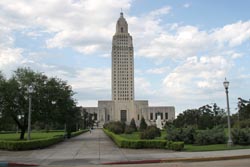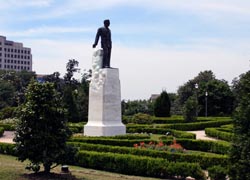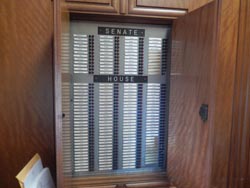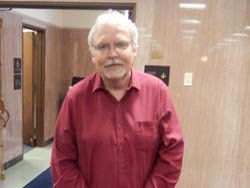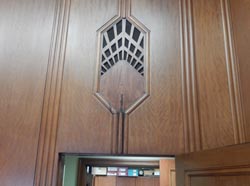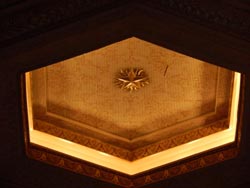Legends and Lore of the State Capitol
By David Kunian
Looming majestically over downtown Baton Rouge, the Mississippi River, and ExxonMobil Baton Rouge Refinery, the Louisiana State Capitol stands 450 feet and 34 stories tall. Built from 1930 until 1932 under the direction of architects Weiss, Dreyfous, and Seiferth and, with the guiding hand of Huey P. Long steering the construction, it is the tallest and most visible building for miles. The Capitol was a dream of Long's once he became governor in 1928. Using his vast influence, he was able to get building on it started in December of 1930. Construction finished in early 1932, but it was not dedicated until May 16, 1932 for the inauguration of Governor Oscar K. Allen. Its venerable status was confirmed by its listing on the National Register of Historic Places in 1978, and its designation as a National Historic Landmark in 1982.
Currently the Capitol holds the voting chambers for both the Louisiana House of Representatives and the Louisiana Senate, the Governor's office, meeting rooms, and some of the various and sundry offices without which the government of Louisiana would cease to run. Even though legislators are restricted by term limit laws from serving too long in the Capitol, there are many people working there who have been there for decades. These are the people who hold the knowledge, oral history, and folklore of the Louisiana State Capitol. Interviews with several of them on assorted topics concerning the legends and lore of the State Capitol are the main thrust of this article. These people are Caucasian and African-American, male and female, rural and urban. They all have worked at the Capitol for decades, and have great experience in how the legislature works and what has happened in and around the thick stone walls of the Louisiana Capitol.
According to the Meriam-Webster dictionary, folklore is defined as "the traditional customs, tales, sayings, dances, or art forms preserved among a people." At the time of this writing, some of the tales that these interviews revealed are both oral history and folklore. They are oral history due to the fact that the people recounting them were there to witness them. Those stories are not stories that have been passed down over many years. However, they have a quality of legend and of being too fantastic to be true. Eventually these stories will take on the status of more traditional types of folklore. Given that several interview subjects told the same story but with different viewpoints and details, these stories already have attained those traits of what is more regularly thought of as folklore.
Huey's Legacy
The topics of which the interviewee spoke can be divided into four basic but open categories. Given his huge influence with regards to the Capitol and the ways in which his history is forever and intricately intertwined with the Capitol, Huey P. Long is a subject that each interviewee broached. There are many legends about Long, his particular style of governing, and his assassination that occupy the thoughts of the people around the Capitol. Another topic concerning which the interviewees were loquacious was the memorable antics and actions of legislators as they go about their work of debating on and voting for bills. These antics have a great variety of humor and viscerality. Also, many interviewees spoke of certain traditions of both the elected officials and the press corps who reports on the daily goings-on of both the representative bodies at the Capitol. Finally there are traditions and legends associated with the building and rooms themselves such as Memorial Hall and both of the legislative chambers.
Huey P. Long was the mastermind behind the building and design of the State Capitol. Before this building was erected, the State Capitol was a Neo-Gothic building closer to the banks of the Mississippi River that had been built in 1847. It had become too small for the size of the state government many years before. While running for governor in 1927, Long suggested the idea in a campaign speech (Kubly 15). When he was voted in as governor in 1928, he began to push the idea in earnest. He chose as architects the firm of Weiss, Dreyfous, and Seiferth to design the building in 1930. Long had a difficult time getting the money appropriated by the legislature in 1930, but after several votes he had the appropriation. Construction began by December 16, 1930. According to Vincent Kubly in his book The Louisiana Capitol: It's Art and Architecture, The Yazoo and Mississippi Valley Railroad had to build a special spur to deliver the 2500 carloads including many tons of limestone, marble, granite, gravel, cement, bricks, terrazzo, and other materials. By early 1932, the construction was finished and the Capitol was done.
By the time the Capitol was finished, Huey P. Long only was governor for a short time before he was elected the U.S. Senator from Louisiana, and the governor became O.K. Allen who was inaugurated on the new Capitol steps in May of 1932. Cinthia Mancuso is the Executive Counsel for the Speaker of the House, and her office is one of the offices that Governors Long first occupied and then Allen worked in.
When interviewed, Mancuso pointed out several features of the office. The first was the voting board in the corner. The board worked until 1999, and it would indicated which way a given legislator had voted on a bill. She said, "From this board, Huey could see how people were voting. It was said that Huey was very controlling. Legend has it that Huey had a switch in his desk for the House and the Senate. When voting was not going how he wanted it, he would cause the whole system to go down so he could go and twist arms and then come back to see how the vote would go. People believe that because there are switches in the desk now." At this point, she walked into the adjacent office where currently belongs to the Speaker of the House but used to belong to the Governor. The original desk is still there and underneath the middle of the desk on the side of the desk where the Governor would sit are two switches. Mancuso demonstrated that the switches don't do anything currently.
Mike Hasten was a Capitol Correspondent for Gannett News for 31 years and is currently a communications specialist in the House Communications Office. He has worked at the Capitol since 1983. He also gave a similar version of this story when was also along for the tour. He states, "Huey would watch the panel with the tally board when there was a vote, and if it were not going his way, the story is that he would turn the machines off. Under his desk there are two light switches where he could turn them off. He could turn them off and go talk to people and twist arms and then go turn them on. Votes would change." When asked about the switch, Alfred "Butch" Speer, currently clerk of the House of Representatives, offers another slightly more mundane theory that it could have been a panic button.
After explaining this, Mancuso came back into the office with the tally board, but then she pivoted and pointed above the door through which we had entered. There was a mesh-like panel above the door as if there was a speaker behind it. "Huey was paranoid," she asserted, "He always had a bodyguard with him, but he didn't want him in the room with him. In the course of putting up the walls here, they created a spot up there behind the speaker panel, a crawl space about six feet by six feet. When they redid the office, they found a chair, cigarette butts, coffee cups, and newspapers from the 1930s. In the bathroom was a set of pull down stairs like attic stairs. Huey would have his bodyguard sit up there and watch over him. He probably had him up there spying."
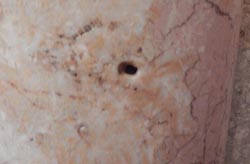
Outside the former governor's office/current speaker's office is the hallway where Long was assassinated in 1935. On the way back up to his office, Hasten stops to point out the spot where Long was shot. He explains that some of Long's bodyguards might have shot Long as they wanted to be the first one to shoot his assassin. Hasten comments, "Dr. Weiss (Huey's alleged assassin) had over 66 bullet holes in him, and Huey didn't even know he was shot until he got downstairs." Before we leave, Hasten points out some of the native animals and flora and fauna that grace the walls and pillars here.
We return upstairs to Hasten's office. He talks about the construction of the Capitol and how Long is on the frieze that goes around the Capitol with the architects leaning over a draftsman's table. Before the interview ends, another story about Huey comes out. "There was a very important football game between LSU and Alabama," reminisces Hasten, "and Huey wanted the railroads to give LSU students a free ride to the game. The railroads said, 'No, we're not going to do that.' 'OK,' said Huey. So he proposed a bill to double the tax on railroads. Guess who went to the football game."
Long also came up in an interview with Brenda Hodge. Hodge, a former Capitol radio correspondent and now Senate Communications officer, says, "Whenever things go missing around here, we blame it on Huey's ghost. 'I can't find that folder!' 'That's Huey's ghost.' Nobody's ever seen the ghost —well, nobody sober's ever seen the ghost, but that's what we say." However, Audrey Fry, current tour guide and former travel counselor for the Capitol, states that ghosts have been seen. In her interview, she confided, "The night security have heard things and seen things. Doors will close or open. A woman told me that she saw a man standing by the lake out there [behind the Capitol] who looked exactly like Dr. Weiss. I've seen a film where the lights in the House chamber were going on and off around midnight. They probably have spirits here; probably Huey and Dr. Weiss."
Memorial Hall and the Chambers
Once exiting Hasten's office and taking the stairs down, I cross the flag-filled Memorial Hall. There are reliefs of assorted Louisiana governors on the doors to the elevators. The gold leaf ceiling and the alternating dark and light tiles of marble reflect each other.
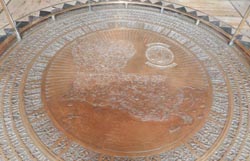
In the center of the hall is a bronze relief map of the state of Louisiana complete with symbols for the major products of each area. A list of the 64 parishes of Louisiana circle the map. At first the railing that surrounds the map was not there, but after the countless feet of legislators, staff, and tourists started to wear down the map, a railing was added around it. Several of the people interviewed said that it was a tradition for the school children who visit the Capitol to take a penny, throw it, and try to hit their parish. Mike Hasten confirmed this with a smile and added, "You have to be good at it because pennies bounce."
Audrey Fry added to this, "It's the habit of kids to treat it like a wishing well. Kids will toss money, and if you hit it, it's good luck. Mr. Jim from the cafeteria would collect the money, and he would buy toiletries for the inmates who do the cleaning and give them to them."
Memorial Hall has often served as the room for important Louisianians to lie in state. Huey Long lay in state here as did David Treen, John Hainkel, and Eddie Robinson. Alfred Speer thinks that "Huey's was the biggest, but there were lots of people for Coach Robinson."
The east wing of the Capitol is the chamber where the Senate meets. Upon entering, on the ceiling in the lit area on the right, one can spy a sliver of wood protruding from the ceiling. There is also a splinter high up in one of the columns across the room. Visitors often look up at the ceiling and wonder why that piece of wood is there and how it got there. According to Hasten, in 1970 there was a big labor/management fight happening in Louisiana. On a Sunday when the Senate was not in session, a bomb went off. Hasten states, "It blew out the first few rows of the Senate. People think it's a pencil." Hodge agrees and adds, "The piece of wood got stuck there when the bomb went off. It demolished the front of the chamber. It was in connection with the right-to-work debate." However, as Alfred Speer puts it, "It took less than a week to rebuild it. They never did find out who did it."
Rituals and Traditions of the Chambers
Both chambers of the Capitol have traditions of their own. Alfred Speer points out that there are certain hazing rituals. "When a new member goes to the lectern to present his or her first bill," he explains, "they are always harassed and asked irrelevant questions. Everyone tries to embarrass that person. The new member has to wear a sign that says, 'This is my first bill,' and the sign has glitter and puff balls on it. And when that first bill is presented, everybody votes "no" on it, including that member. And that member has to see that they voted against their own bill." Speers also points out that there is a more formal ritual of an outgoing member saying "goodbye" that is more serious.
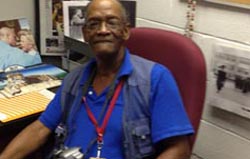
Another ritual that has occurred over the years is Sine Die, which literally is Latin for without a day, that indicates adjourning indefinitely, i.e., the end of the legislative session. The session used to close at midnight, and photojournalist James Terry talks about how all the journalists covering the session would "gather on the Louisiana step in front of the Capitol, each person with their own champagne bottle, and shoot off their corks to celebrate."
Mike Hasten also remember participating in this tradition, but recalls that the journalists "shot off their corks at the statue of Huey Long. The corks never hit the statue, but some hit the parking lot."
According to Alfred Speer, there is another ritual that specifically occurs when school classes visit the chambers. Kids from such schools observe the legislators' work from the balcony. Usually the legislator from whose district the class comes gets a note sent to him, and then the legislator recognizes the group from the floor. After that, it is the tradition that such legislator is expected to buy the class ice cream from the cafeteria on the floor below.
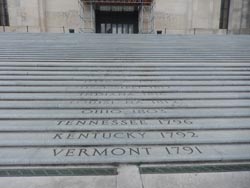
Legislators in both the Louisiana House of Representatives and Senate are known for far more than buying ice cream for school kids. Louisiana is a state known for its uniqueness and characters, and many of the lawmakers voted by the citizens of Louisiana are no exception. Each of the subjects interviewed told several stories about the legendary antics of Louisiana representatives that occurred during sessions or debates or even simply around the Capitol. One of the most famous involves Governor Jimmie Davis. Several interview subjects mentioned this. James Terry tells the story that apparently Davis, on the last day of the session during a term when he was term limited, he rode his horse Sunshine up the steps of the Capitol, and he brought his horse into his office. Other subjects dispute whether he brought the horse into the building or not. The joke is that it may have been the first time when a horse had been in the building, but it was not the first time that a horse's ass had been in the building (referring to the personalities of the some of the legislators who work there).
Politician Antics
In her interview, Brenda Hodge has a great addendum to that story. She was working for a radio station in Shreveport as their political reporter. It was the Sunday after the election where Governor Edwin Edwards was in a run-off against soon-to-be Governor Buddy Roemer. Edwards had decided to concede because he didn't think he could beat Roemer, and wanted not to have ever lost an election. Hodge was putting together her morning report and came to do her stand up by the Capitol. She looked to her left, and 2 horses were coming by the Capitol. One had Edward on it, and another had one of his advisors. Hodge came down to him, chatted for a few minutes, and then asked him if he was going to ride his horse up the steps like Jimmie Davis. Edwards' reply was "I've got more sense than Jimmie did."
Louisiana's other elected officials have not been immune to spectacle and antics in the performing of their duties. Many bills have included some over-the-top theatre to demonstrate the finer points of the law in their debates. Both Ms. Hodge and Mr. Hasten remember a mandatory helmet law that came across the floor of the House. The bill had been proposed many times, but had never gotten anywhere. On this occasion, the representative whose bill it was came to the session with two heads of cabbage and a motorcycle helmet. In explaining the benefits of his bill, Hodge says that "he took a baseball bat out of his briefcase and smashed a cabbage. It went everywhere. He said, 'This is your brain without a helmet.' Then he took the other head of cabbage, and puts it in the helmet, and hits it. Nothing happens. Then he said, 'This is your brain with a helmet.' The bill got out of committee that year." Hasten tells the similar story, but he adds that while this bill was being debated, there were motorcycle gangs riding around the Capitol.
Hasten also related his memories about the gill net legislation. People had proposed legislation to limit or ban gill nets. Hasten explains, "Commercial fisherman were raking in money with those nets. Recreation fishermen wanted to band the gill nets. This bill failed for a couple years. Then they brought in a mile-long gill net, and they strung it around the House chamber and in front of the door, and threw frozen fish in there. The bill passed." Alfred Speer adds, "The representatives couldn't get out, much to the chagrin of the members who wanted to go to the bathroom."
While on the topic of bathrooms, most of those interviewed got a laugh when talking about the 14 hours filibuster done by Senator James David Cain. Cain was getting upset about the reapportioning of house districts, so he got up on the floor of the Senate and remained there for 14 hours reading books and telling stories in order to filibuster the bill. Staff and officials were catching naps on couches. At some point during his speeches and such, Cain admitted that he was wearing Depends so that he didn't have to leave the floor to use the bathroom.
Speer also remembered a legislator named Shady Wall from Monroe. Wall would change his suit three times each day. He also loved to show that he was the only certified sane member of the legislature. Someone had tried to commit him, and he found a doctor to certify that he was sane, and he kept the certificate.
Representative Troy Hebert is also a character who was famous for some of the ways he used to persuade fellow members to vote on bills. When Hebert was fighting a law banning cock-fighting, he brought a live chicken in a cage to the debate, and then let it out, so, as Speer puts it, "There was a live chicken running around. He took it over to where he lived in the Pentagon Barracks where it lived for a year. The chicken would crow at sun rise." Mike Hasten remembers that or another debate with Hebert about cock fighting where he brought a bag of Winn Dixie frozen chicken in it and pictures of beautiful, fighting cocks. He made sure to point out the difference between the two. Hebert also apparently showed up to his swearing-in ceremony wearing jeans and a casual shirt. He couldn't be sworn in because he was not dressed appropriately. Speaker Hunt Downer sent out to the thrift store to get Hebert dressed in suitable clothes. After he was sworn in, Hebert was thanking everybody, and he was heard to say, "I know you all think that I fell off a turnip truck on my way here. No, I was driving that turnip truck."
Even former Speaker of the House and Senate President John Hainkel was not immune to illustrating his points with props. Speer tells the tale of a member who wanted to adopt a bottle bill that would put a deposit on each glass bottle purchased in the state. Speer says, "Hainkel spent half a day stopping on Airline Highway picking up trash, and he brought this huge bag of trash to the lectern when the bill was being debated to show what would not be on the side of the road. He emptied the bag on the floor of the House, breaking several bottles and making a great mess."
Hainkel was also part of another tradition in the Senate. This tradition involved a wager between the senators who were Tulane University football fans and the senators who were Louisiana State University football fans. (Hainkel was a Tulane fan.) As Brenda Hodge remembers it, whoever won each year, the other team's supporters had to bring the members who supported the winning team into the chamber in a wheelbarrow. One year Tulane won, and Hainkel was wheeled into the chamber in a wheelbarrow in a ceremonial manner. In telling this story, Hodge also remembered two occasions when helicopters flew in senators on their sick beds because their votes were needed. She did not remember the precise years, but one was Senator Nat Keifer who was being treated for cancer, and another was Senator Tommy Hudson who was having back surgery. Both were helicoptered in, wheeled in on stretchers, and then they voted.
In terms of voting, everyone interviewed had a story about instances when time stopped in the chambers. That is how they put it, but what they went on to elucidate was that the clocks stopped in order to give legislators more time to debate or vote. Hodge stated that one time James Jumonville apparently threw his shoe at the clock to stop it. In those days, legislative sessions ended at midnight. The People of Louisiana decided to change this and end at 6.
On that particular night, it was getting near midnight. . . . And the clocks stopped at 2 minutes before midnight in both the House and the Senate. They unplugged the electric clocks. Lots of people were murmuring about it, but there was a very important piece of legislation that had not passed. If I recall, it was the actual budget for the coming year, and it was still being jockeyed around, and so whenever it stopped and everybody was murmuring, they noticed that some of the top people were not there, and after a brief while, they came back in, passed the bill, plugged the clock back in, and everybody adjourned at what the clock said was midnight.
Another year a vote was needed in the chambers, but a quorum was not present. They couldn't vote nor adjourn without a quorum. So the State Police locked the doors so no one could leave and went out to find the representatives to put together a quorum. Hasten says they went to favorite watering holes, restaurants, apartments, and other places. It took 3 hours to find them, and one member came in to vote in slippers and a bathrobe.
Many of those interviewed say that things have become calmer as time has passed. The members are less eccentric and less likely to do outrageous acts to pass their bills or get their ideas across. Alfred Speer, having worked at the Capitol since 1972, says that it was more colorful then. "Back in the late 1970s," he says from behind his desk that is below the House Chamber, "anyone could walk onto the floor of the House and sit down and have a chat. It was even more chaotic then than now. There are stories about constant eating on the floor, and throwing food at each other. It's always centered around chicken bones being thrown. Now it's rubber bands that they flick at each other." Hasten is in agreement with Speer on the point that "there is less craziness and flamboyance with the members." He guffaws in his explanation of it. "You want to know why?" he laughs, "It's because they're all Republicans!"
Conclusion
As was detailed at the beginning, this essay illustrates the fine line between folklife and oral history. Currently the people who were interviewed remember what they recounted. They were present for many of these incidents. To them and to us in this moment, this is oral history. However, as time passes and these historical facts are recorded and passed down either as written or orally from person to person, they can become folklore and legend in the same way that the story of George Washington chopping down the cherry tree or Buddy Bolden playing so loudly that they could hear him across town in the French Quarter is.
Sources
Fry, Audrey. 2015. Interview by David Kunian. September 25.
Hastern, Mike. 2015. Interview by David Kunian. August 18.
Hodge, Brenda. 2015. Interview by David Kunian. August 28.
Kubly, Vincent. 1995. The Louisiana Capitol: It's Art and Architecture. Gretna: Pelican Publishing.
Mancuso, Cinthia. 2015. Interview by David Kunian. August 18.
Speer, Alfred "Butch". 2015. Interview by David Kunian. August 28.
Terry, James. 2015. Interview by David Kunian. August 12.



